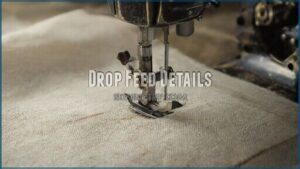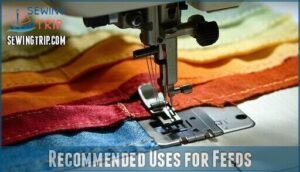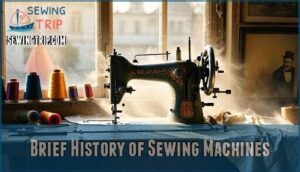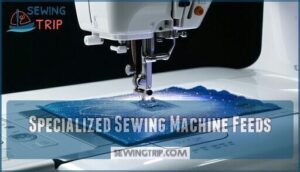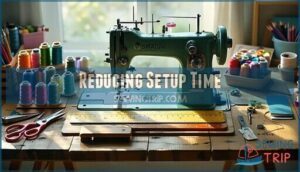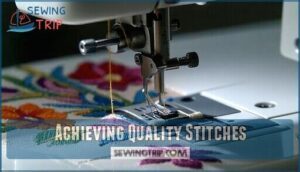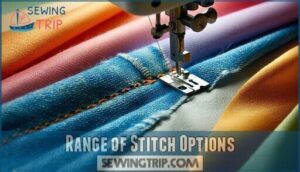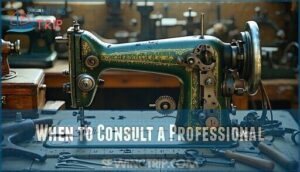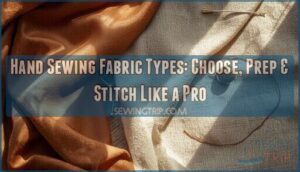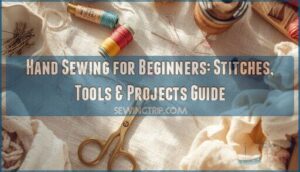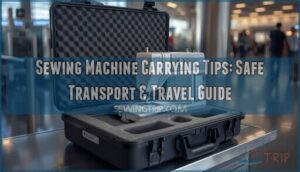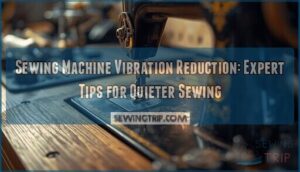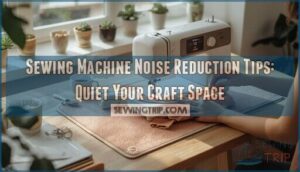This site is supported by our readers. We may earn a commission, at no cost to you, if you purchase through links.
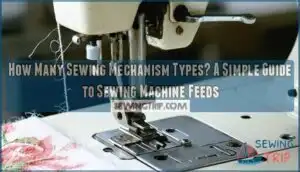 Sewing machines use several mechanisms to create stitches and move fabric efficiently.
Sewing machines use several mechanisms to create stitches and move fabric efficiently.
The main types include the needle mechanism, which forms stitches; the bobbin and shuttle mechanism, managing the lower thread; and the feed-dog mechanism, responsible for fabric movement.
For fabric feeding, machines rely on systems like drop feed (standard), differential feed (great for stretchy fabrics), and unison feed (ideal for thick layers).
Specialized feeds, like puller feeds, handle heavy-duty tasks.
Each mechanism works in harmony, like a well-rehearsed orchestra, ensuring smooth stitching.
Curious how these feeds adapt to different materials?
There’s more to explore about tailoring your machine’s setup!
Table Of Contents
- Key Takeaways
- Main Sewing Machine Feeds
- How Do Feed Mechanisms Work?
- Recommended Uses for Feeds
- How Do Sewing Machines Stitch?
- Brief History of Sewing Machines
- Specialized Sewing Machine Feeds
- Reducing Setup Time
- Achieving Quality Stitches
- Range of Stitch Options
- When to Consult a Professional
- Frequently Asked Questions (FAQs)
- Conclusion
Key Takeaways
- You’ll find four main sewing mechanisms: the needle system, feed system, bobbin mechanism, and thread tension control, all working together for smooth stitching.
- Each feed mechanism, like drop feed or puller feed, adapts to specific materials, ensuring precise and consistent stitching results.
- Adjusting feed settings, such as differential feed ratios or top feed controls, helps manage tricky fabrics like knits or slippery textiles.
- Regular maintenance, like cleaning and adjusting feed dogs, keeps your sewing machine performing at its best for any project, including those with smooth stitching.
Main Sewing Machine Feeds
In regards to sewing machine feeds, understanding the main types can make your projects smoother and more precise.
Each feed mechanism, like drop feed or puller feed, has a unique way of moving fabric to guarantee consistent stitching, and this is crucial for achieving professional results with precise stitching.
Drop Feed
The drop feed is the simplest sewing machine feed mechanism, relying on feed dogs, a throat plate, and pressure foot tension to move fabric.
While great for general sewing, it struggles with fabric shifting, especially on lightweight materials.
Feed dog height plays a critical role in stitch consistency, so adjustments may be needed, and this mechanism works by moving fabric in sync with the needle’s motion.
It’s versatile but demands attention to avoid misaligned stitches, and guiding layers smoothly requires skill.
Differential Bottom Feed
If you’ve ever struggled with stretchy or lightweight fabrics slipping around, the differential bottom feed is your hero.
The differential bottom feed tames slippery fabrics, ensuring smooth, precise stitching without the frustration of shifting or puckering.
This sewing machine mechanism uses two feed dogs moving at different speeds to control fabric tension and prevent shifting.
With an adjustable feed ratio, you can tailor it to your project’s needs.
- High feed settings: Keep knits from stretching out.
- Low feed settings: Avoid puckering in woven fabrics.
- Feed adjustment dial: Typically ranges from 1.0 to 2.0.
This feed mechanism guarantees smooth seams and professional results, making it a must-have for tackling tricky fabrics with confidence.
Adjustable Top Feed
Managing slippery materials or gathering fabrics is easier with an adjustable top feed. This sewing machine mechanism lets you control the upper fabric layer separately, ensuring smooth, precise stitching.
By syncing with the feed dogs below, the top feed adjustment prevents shifting or puckering, even on tricky textiles. Think of it as a steady hand guiding your fabric.
Some models even offer digital top feed options, making adjustments quick and hassle-free. It’s a game-changer for fabric control and professional results.
Needle/Compound Feed
If you’ve handled slippery or thick fabrics, you’ll appreciate the needle/compound feed mechanism.
It combines needle synchronization with precise feed dog timing, ensuring smooth, even stitches.
Unlike basic feed mechanisms, the needle moves both vertically and horizontally, gripping the fabric as the feed dogs advance it.
This system excels in industrial applications, especially for upholstery or leatherwork, where avoiding holes and maintaining stitch consistency are critical.
For ideal results, be sure to select compatible needle systems for your machine.
The compound feed’s synchronized motion minimizes puckering and fabric shifting, making it a favorite for professionals tackling multi-layered or heavy materials with ease and precision.
Unison Feed
If the needle/compound feed excels with thick fabrics, the unison feed is your go-to for slippery fabrics and tricky materials.
This feed mechanism synchronizes the needle, presser foot, and feed dogs, ensuring smooth fabric movement with minimal top/bottom motion.
It’s perfect for sewing machine feeds that demand precision, like tents or upholstery.
The unison feed grips materials evenly, reducing puckering or shifting.
Whether you’re tackling heavyweight layers or delicate textiles, this sewing machine mechanism guarantees feed synchronization, keeping every stitch aligned and your seams flawless.
One such machine is the JUKI PLC-1760-7, known for its use with heavy materials.
Think of it as teamwork in motion!
Puller Feed
How does the puller feed keep seams flawless? It’s all about precision and control.
This feed mechanism uses motor-driven belts to maintain fabric alignment and prevent material slippage, even during high production speeds. Perfect for heavy-duty tasks, it guarantees straight stitches on long seams.
- Belt Tension: Maintains stability.
- Fabric Alignment: Prevents shifting.
- Production Speed: Handles fast stitching.
- Maintenance Needs: Requires occasional adjustments.
How Do Feed Mechanisms Work?
Feed mechanisms work by moving the fabric under the needle in precise steps, ensuring each stitch lands exactly where it should.
Whether it’s feed dogs pulling from below or a walking foot handling thick layers, the goal is smooth, even stitching without fabric slipping or puckering.
Drop Feed Details
The drop feed is the backbone of sewing machine mechanisms, relying on feed dogs, a throat plate, and a pressure foot to move fabric.
It’s straightforward but needs finesse—fabric type suitability matters to avoid ply shifting.
Feed dog motion guarantees each stitch advances evenly, while pressure foot adjustments help maintain grip.
Troubleshooting issues like uneven stitches often starts with these core sewing machine parts, including the consideration of fabric type.
Other Feed Types
Let’s look at some other feed mechanisms that tackle fabrics like pros. These are your go-to options for specialized applications or trickier materials.
- Compound feed: Perfect for thick fabrics, it syncs the needle and feed dog strokes to avoid skipped stitches and needle holes. Think upholstery or heavy-duty projects.
- Unison feed: Handles slippery or layered fabrics by keeping top and bottom motions in harmony. No more fabric shifting!
- Puller feed: Uses motor-driven belts to keep long seams straight and aligned, a favorite in production lines.
For DIY feed mods or feed customization, these mechanisms offer flexibility. Proper maintenance guarantees smooth fabric feeding. Rare feeds like differential bottom feed or adjustable top feed further expand your creative possibilities.
Recommended Uses for Feeds
You’ll want to match the feed type to your fabric and project needs for the best results.
From managing thick layers to preventing puckering, each feed mechanism has its own strengths to make sewing easier, particularly in terms of preventing puckering.
Walking Foot
Tackling layered projects like quilts or heavy fabrics? A walking foot is your secret weapon.
This specialty foot pairs top and bottom feed mechanisms, gripping fabric layers evenly to avoid dreaded fabric pucker. Whether you’re quilting or sewing thick materials, it guarantees smooth, aligned stitches without slippage.
Adjusting foot pressure enhances its performance, making it a favorite for tricky tasks. You can find more information about available walking foot products.
Here’s a quick comparison of its benefits:
| Challenge | Walking Foot Solution |
|---|---|
| Fabric shifting | Even layer advancement |
| Puckering on seams | Smooth, flat stitches |
| Handling heavy fabrics | Balanced feeding power |
| Quilting applications | Perfectly aligned layers |
| Specialty feet needs | Versatile sewing machine use |
Compound Walking Foot
The compound walking foot is a game-changer for handling heavy materials.
By synchronizing the needle and feed mechanisms, it guarantees smooth fabric movement and exceptional stitch quality.
You’ll love how it simplifies tough projects like quilts or canvas bags.
For more information, you can explore available options.
- Fabric Handling: Glides multiple layers without puckering.
- Needle Synchronization: Keeps stitches aligned on thick fabrics.
- Foot Pressure: Adjusts perfectly for consistent results.
With this feed mechanism, sewing machines tackle challenging layers like pros!
How Do Sewing Machines Stitch?
Stitch formation in a sewing machine is a fascinating dance of precision.
Every stitch relies on coordinated movements between the needle, thread, and bobbin system.
Here’s how it works:
- Needle Movement: The needle pierces the fabric, carrying the top thread down.
- Thread Tension: The take-up lever pulls the thread tight for a clean stitch.
- Feed Dogs: These move the fabric forward, readying it for the next stitch.
- Shuttle Movement: The shuttle or bobbin case catches the thread below.
- Bobbin Interaction: The bobbin thread loops with the top thread.
- Needle Timing: The needle rises, releasing tension.
- Fabric Advancement: Feed dogs position the fabric for the next cycle.
This sewing mechanism creates seamless stitches in seconds—like clockwork!
Brief History of Sewing Machines
Before sewing machines, stitching by hand was the only option—painstaking and slow.
Early inventors like Elias Howe and Isaac Singer revolutionized this with groundbreaking sewing machine innovations in the 1800s.
Howe’s design introduced the lock stitch, while Singer’s affordable models brought sewing machines into homes and factories.
These key innovations sparked the machine evolution, transforming garment production from tedious handwork to efficient automation.
The industrial impact was massive, birthing modern clothing factories and reshaping economies.
Today’s sewing mechanisms trace their roots to these advancements, proving how a simple idea can stitch together the fabric of progress and future trends.
One notable development was Thimonnier’s early machine, which used chain stitches for straight seams.
Specialized Sewing Machine Feeds
You’ll find specialized sewing machine feeds like collarette attaching, dry head technology, and digital top feed designed for unique tasks that standard feeds can’t handle.
These innovations help you tackle tricky fabrics, achieve cleaner finishes, and speed up production without breaking a sweat, thanks to features like dry head technology.
Collarette Attaching
Collarette attaching is a specialized sewing technique that guarantees neat, professional seam finishes on knit garments.
Using feed mechanisms like unison feed, your sewing machine evenly handles collarette materials without puckering or shifting. Adjusting tension settings and attachment methods is key to achieving flawless results.
To simplify the process, consider using a specialized sewing tool.
- Fabric compatibility: Works well with cotton, polyester, and Lycra.
- Attachment methods: Collarette attachments streamline the process.
- Seam finishes: Creates clean edges with precision.
- Tension settings: Proper adjustments prevent uneven stitching.
Mastering this technique elevates your sewing projects to production-quality standards.
Dry Head Technology
Dry head technology is a game-changer for clean stitching.
Dry head technology ensures spotless stitching by eliminating oil stains, revolutionizing sewing precision and maintenance.
By eliminating internal oiling, it prevents fabric stains while reducing sewing machine maintenance. This oil-free sewing innovation guarantees component longevity and keeps high-speed operations running smoothly.
Perfect for mass production, it delivers precision at up to 7,000 stitches per minute. Say goodbye to greasy mishaps and hello to spotless, professional results!
Digital Top Feed
With digital top feed, you’ll get stitch consistency and fabric adaptation like never before.
This feed mechanism uses programmable control and sensor integration to prevent twists and guarantee smooth feeding.
It’s perfect for delicate or tricky materials.
- Digital precision: Guides fabric evenly for flawless results.
- Top feed controls: Adjust easily for different fabrics.
- Sewing machine technology: Reduces setup time while boosting efficiency.
Reducing Setup Time
Cutting down your sewing machine setup time doesn’t have to feel like threading a needle in the dark. A little preparation and attention to detail can make all the difference.
- Ergonomic Workspace: Position your machine at a comfortable height and keep essentials within arm’s reach.
- Streamlined Threading: Practice threading your machine until it’s second nature.
- Organized Tools: Store bobbins, needles, and accessories neatly for quick changes.
- Bobbin Management: Pre-wind bobbins in common thread colors to save time mid-project.
Regular sewing machine adjustment is key. Shim and align feed dogs for smooth fabric flow, lubricate moving parts, and replace worn components like the throat plate. With proper sewing machine optimization, you’ll breeze through projects with ease.
Achieving Quality Stitches
Achieving quality stitches boils down to mastering a few essentials.
Start with proper tension balance—your thread tension should be tight enough to hold but loose enough to flow smoothly.
If stitches look uneven, adjust tension dials gradually.
Needle choice is equally critical; match the needle size and type to your fabric.
A heavy fabric needs a stronger needle, while delicate material calls for a finer one.
Don’t overlook thread quality—cheap thread can fray and ruin stitch consistency.
Also, consider your fabric type and stitch settings; lightweight fabrics may need shorter stitches, while thicker ones require longer lengths.
Finally, make certain of proper stitch formation by keeping your sewing machine clean and well-oiled.
A little maintenance goes a long way!
Range of Stitch Options
Your sewing machine offers a world of stitch options, from classic straight stitches to intricate decorative stitch patterns.
Each stitch type serves a purpose—whether it’s for durability, flair, or functionality. With programmable stitches, you can explore endless possibilities, like mimicking hand-sewn looks or creating custom patterns.
Adjusting stitch density lets you perfect the look and strength of your work, especially when using specialty threads. Decorative stitches add personality, turning simple projects into standout pieces.
Stitch customization isn’t just practical; it’s creative. Whether you’re crafting heirlooms or experimenting with pattern creation, modern sewing machine stitch types make every project a chance to innovate and create standout pieces.
When to Consult a Professional
If your machine isn’t stitching right after trying everything, it’s okay to ask for help.
Some issues, like timing problems, motor glitches, or other complex repairs, need a pro’s touch.
Here’s how to decide:
- Check the manual: It’s packed with tips for sewing machine troubleshooting and maintenance.
- Explore forums: Sewing enthusiasts share solutions for everything from intricate projects to odd noises.
- Weigh costs: If repairs seem pricey, compare them to the machine’s value.
Sometimes replacement makes sense.
When all else fails, sewing machine repair services can save time and frustration.
Regular maintenance includes oiling moving parts to reduce friction.
A professional consultation keeps your machine humming smoothly!
Frequently Asked Questions (FAQs)
How a sewing machine works?
A sewing machine is like a choreographed dance—needle, thread, and feed dogs move in harmony.
You guide fabric while the motor powers the needle, forming stitches by locking top and bobbin threads together seamlessly.
How many moving parts does a sewing machine have?
A sewing machine has dozens of moving parts, including the needle, feed dogs, bobbin case, shuttle, and take-up lever.
These components work together like a choreographed dance to create precise, consistent stitches on fabric.
How many stitches can a sewing machine do per minute?
A sewing machine is like a speed demon on fabric, stitching anywhere from 600 to 1,500 stitches per minute.
High-end industrial models can even hit 5,000!
It depends on the machine’s type and purpose.
What do you need to know about a sewing machine?
You’ll need to understand key parts like the needle, bobbin, and feed dogs, how to thread it properly, adjust tension, and select stitches.
Regular maintenance keeps it humming—think of it as sewing machine TLC!
What are the components of a sewing machine?
You’ve got key parts like the needle, presser foot, feed dogs, bobbin, handwheel, and thread guides.
Each plays a role—think of them as a team ensuring smooth stitches and frustration-free sewing.
What is the anatomy of a sewing machine?
Think of a sewing machine as a teamwork powerhouse.
It includes the needle, bobbin, feed dogs, presser foot, handwheel, and motor, all working together to stitch fabric seamlessly.
Keep them clean, and they’ll perform beautifully!
How many different types of sewing machines are there?
Imagine you’re picking a sewing machine for denim.
You’ll find mechanical, electronic, computerized, embroidery, overlock, coverstitch, and industrial types.
Each suits specific tasks, from basic repairs to professional-level stitching.
Choose wisely for your projects!
What are the four basic working mechanisms of a sewing machine?
A sewing machine’s four basic mechanisms are the needle system, feed system, bobbin mechanism, and thread tension control.
These work together to stitch fabric smoothly, ensuring precision and durability in every project you tackle.
How many sewing techniques are there?
Picture a world of endless stitches—there are dozens of sewing techniques!
From straight and zigzag to decorative embroidery and quilting, each method transforms fabric with precision, offering creative solutions for every project and material. Each method transforms fabric with precision.
What are the 10 types of sewing professionals?
You’ve got patternmakers, tailors, seamstresses, upholsterers, costume designers, alteration specialists, industrial sewing operators, embroidery experts, quilting artists, and fashion designers.
Each role brings unique skills to stitching, crafting, and creating fabric masterpieces.
Conclusion
Picture your sewing machine as a symphony, where each mechanism plays a key role.
Understanding how many sewing mechanism types exist helps you tailor your setup for any project. From drop feeds to puller feeds, each system adapts to different materials, ensuring smooth, precise stitching.
Don’t hesitate to experiment and adjust—your machine’s versatility is its greatest strength. Whether you’re sewing silk or denim, mastering these feeds opens up endless creative possibilities.
Keep exploring, and happy stitching!

